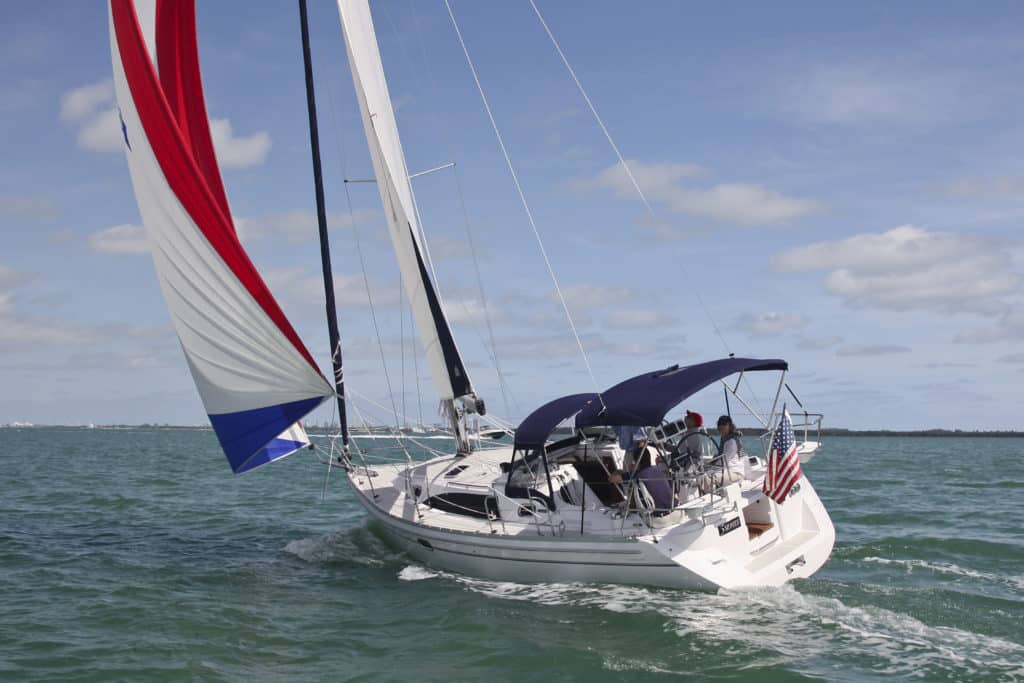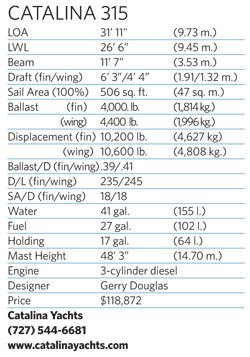
In the last three years, Catalina Yachts has revamped and redesigned its entire line under the collective banner of the 5 Series, which includes the 355, the 385, and the 445. The fourth and most recent member of the clan is the 315, and as the late-afternoon shadows lengthened on Biscayne Bay, we stepped aboard the boat and shook hands with the architect of these changes, Catalina’s chief designer, Gerry Douglas.
Douglas readily admitted that for many years, Catalina’s corporate philosophy was to be the “price leader” in the new-sailboat marketplace, but with the introduction of the 5 Series, the company has made a conscious effort to maintain good value while also loosening the purse strings a bit to provide a level of standards and features that some might not expect from the brand. Douglas cited bigger engines, larger battery banks, generous electrical panels, increased tankage, and all-teak interiors—in a package that’s better built, more comfortable, and performs better—as examples of what Catalina is trying to achieve.
Yes, that sounds like a tall order bordering on hyperbole. But over the years I’ve sailed many a Catalina, and in my opinion, with the 315, at the very least, Douglas and his team have significantly raised the quality bar.

At just under 32 feet, the 315 feels like a much bigger boat. Little touches make significant differences. Take the split backstays for the lofty, double-spreader rig, which open up the space in a cockpit that’s already wide, workable, and ergonomically balanced. Or the extended settee in the main saloon—to starboard, opposite a spacious U-shaped settee, dining table, and galley—which wouldn’t be out of place on a boat 8 feet longer and which maximizes the interior space by doubling as the seat for the aft-facing navigation station.
On the 315, the little things keep adding up, and as the old adage goes, the whole is greater than the sum of its parts. Take the curved handrails strategically placed from the cockpit going forward, so you have something to grasp on to while moving about the boat. Or the dual companionway closures, a folding door on hinges for everyday use and traditional slots for offshore work. Or the little sprit for the asymmetric sail, so the tack is set forward of the bow for utility and efficiency. Or the huge anchor locker, the aft side of which doubles as a collision bulkhead.
Of course, all this would be moot if the boat sailed poorly, but the 315 had that base covered as well. Again, with the breeze still less than 10 knots, the frisky little sloop registered 6.8 to 7.0 knots with the easily set asymmetric cruising kite sheeted in on a tight reach. By the time we doused it, the wind, unfortunately, had vanished completely, but under power, the 315 still moved well, just topping 7 knots at 2,800 rpm.
Before we’d gotten under way, I’d received the subtle impression that Gerry Douglas was quite pleased with his latest work. After testing the boat, now I realized why.
The Catalina 315 is Cruising World’s 2013 Boat of the Year, Best Inshore Cruiser.
View a gallery of the Catalina 315 here.








